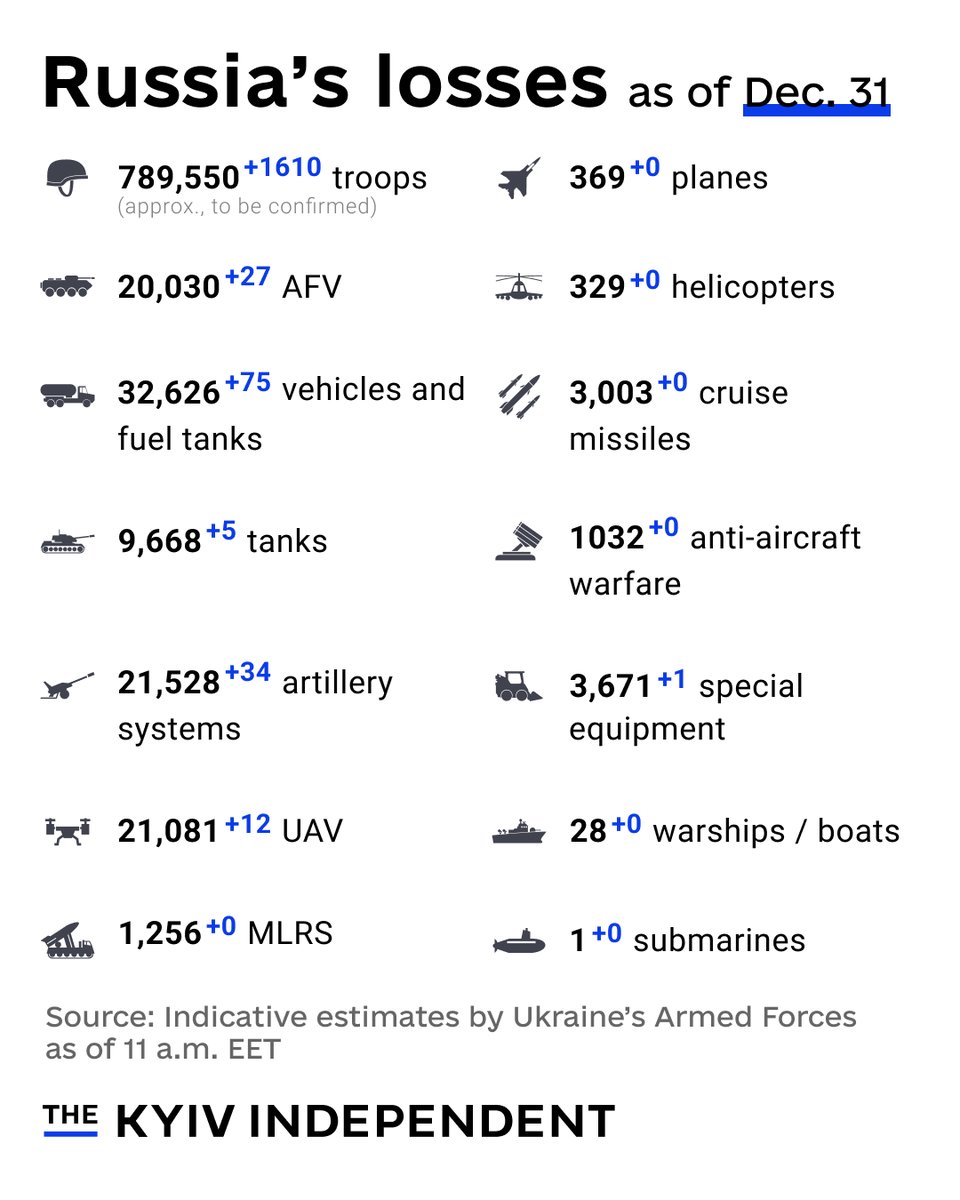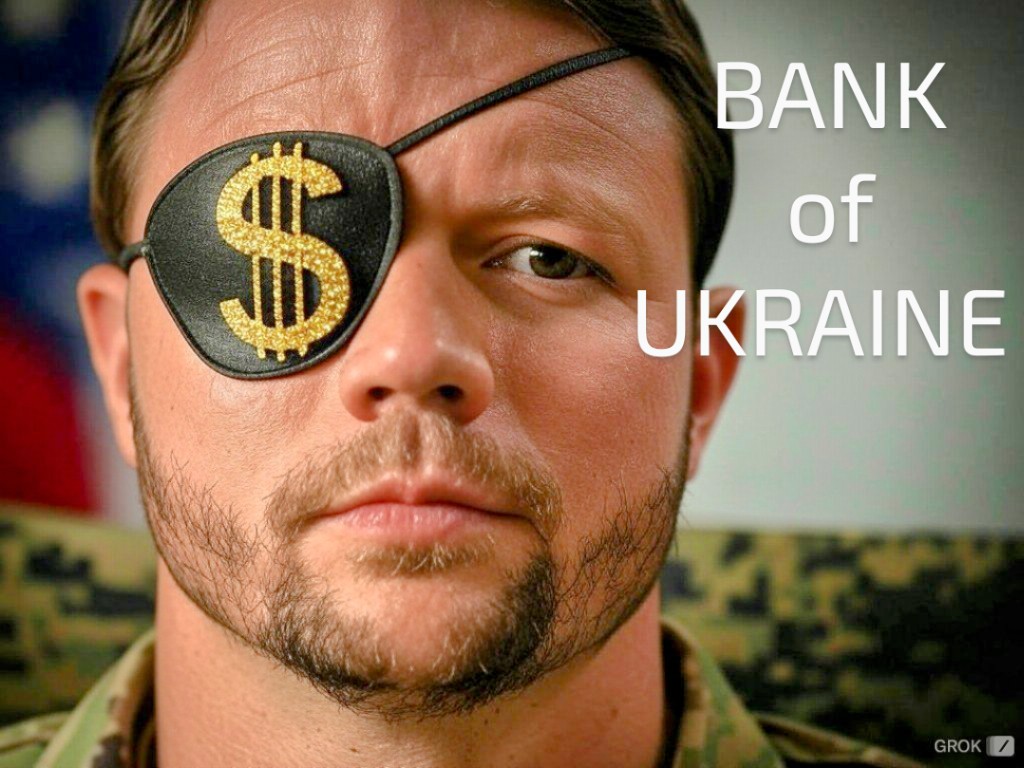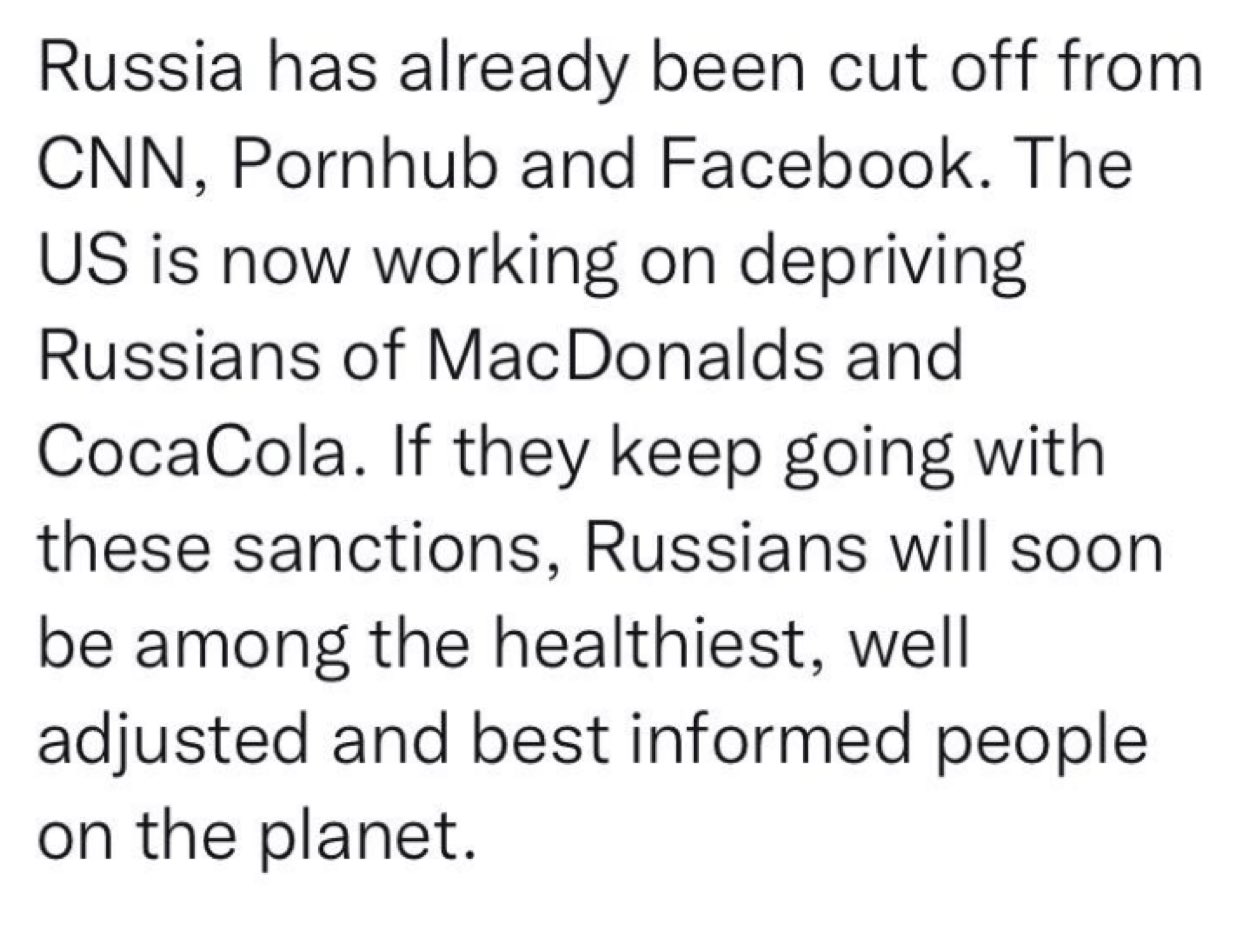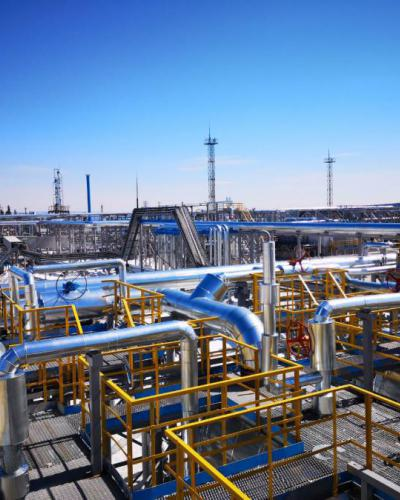
Posted on 02/24/2024 5:59:01 AM PST by SpeedyInTexas
Russian border guards withdrew from the Agarak border checkpoint on the Armenia-Iran border on December 30 after controlling the checkpoint for over 30 years. Armenian Prime Minister Nikol Pashinyan announced that Armenian border troops began solely patrolling the Agarak checkpoint without Russian forces on December 30, indicating that Russian border guards likely withdrew from the area in accordance with the October 2024 agreement that Armenian border guards will regain control of the checkpoint starting January 1, 2025.[11] Pashinyan added that Russian border guards have been operating at the Agarak checkpoint since 1991. Russia's withdrawal from Agarak checkpoint comes five months after Russian border guards completed withdrew from Yerevan's Zvartnots International Airport and further showcases Armenia's commitment to reducing bilateral security relations with Russia.[12]
Russian field commanders are reportedly continuing to brutally punish Russians who refuse to fight in Ukraine. Russian opposition outlet Astra reported that a Russian assault detachment commander deliberately mined fields near Stelmakhivka (southeast of Kupyansk) to prevent elements of the Russian 423rd Motorized Rifle Regiment (4th Guards Tank Division, 1st Guards Tank Army [GTA]) from withdrawing from forward positions in September 2024.[67] Astra reported that the commander ordered a Russian serviceman to shoot Russian personnel who that withdrew from their positions.
more + maps https://www.understandingwar.org/backgrounder/russian-offensive-campaign-assessment-december-30-2024
Here is the Chinese video with Eng subtitles:
What if Russia were crushed by the US? This Chinese video tackles the issue of potential second Russian disintegration and suggests that in such event of Russia’s collapse, China should rush to seize Russian territories so that they do not harbor US bases.
https://x.com/vtchakarova/status/1873788846158008684
Re Russian attack against the Azerbaijan Airlines:
This 20 seconds from Reagan’s address to the nation after Korean Airlines Flight 007 was shot down by the Soviet Union perfectly describes Russia then, and now. Barbarism. Tell me they have changed at all. They have not.
https://x.com/hissgoescobra/status/1871954587818570067
20 sec video

📻🚁 In the radio intercept obtained by intelligence, the pilot of a Russian Mi-8 helicopter hit by a missile from a Magura V5 sea drone panics and explains the nature and consequences of the fire damage to the side, - GUR
“There was a bang - I was hit. It was launched from the water. After that there was another flash. I didn't see where it went, but the first one went straight to me and exploded somewhere nearby - I felt it in the helicopter, some systems failed.”
https://bsky.app/profile/maks23.bsky.social/post/3lelucg2vsc2b
1 min video
Simply falling debris, nothing to see here😎
Kim Fatty III and Putler “designing and vigorously implementing new projects” for 2025... https://freerepublic.com/focus/news/3328416/posts?page=85#85



Reporting From Ukraine:
https://www.youtube.com/@RFU/videos
Reporting From Ukraine Uncensored Combat Footage (from this and past Reports) is found on Telegram:
https://t.me/RFUEnglish or @RFUEnglish
[ You need to have the Telegram app to view the larger videos. ]
The complete transcript.
—
[ North Korean Human Sacrifice Tactic: Using Human Bait For Drones ]
Today [ Dec 30, 8 pm ], there are a lot of interesting updates from the Kursk direction.
Here, in a desperate attempt to break through Ukrainian defenses near Kruglenkoe, North Korean troops resorted to human bait tactics, sending selected soldiers to their death to distract Ukrainian drone operators. However, their poorly executed strategy led to catastrophic losses, leaving the battlefield littered with bodies, and no results to show for it.
Recently, the Russian command decided to re-prioritize their advance in the area of Kruglenke, to achieve the primary goal of their current phase of the counteroffensive. These series of attacks play a vital role in the achievement of their broader operational goal of taking Malaya Loknya and eliminating the northern part of the Kursk salient.
Previously, Russian forces failed in their flank attack north of Novoivanovka, diminishing their chances of bypassing the main Ukrainian defenses in and around the village. This failure prevents them from accelerating their advance toward Malaya Loknya, as the main highway to the town remains under Ukrainian control.
Consequently, their only viable option is to persist with attacks near Kruglenke, where breaching Ukrainian defenses could enable them to advance on Malaya Loknya. However, the Russian forces cannot afford to allocate a significant number of troops and resources to this section of the frontline, without weakening their positions in other parts of the Kursk salient.
To pursue their objective of capturing Kruglenkoe, Russian generals once again opted to utilize North Korean troops to compensate for the shortage of Russian personnel, allowing them to sustain their advance, while attempting to bypass Ukrainian defenses around the village.
The tactical terrain around the Kruglenkoe area provides North Korean fighters with the opportunity to gather and prepare for assaults within the nearby forests. These wooded areas serve as a natural cover, enabling the North Koreans to amass their forces in significant numbers.
This buildup aims to achieve numerical superiority, which they intend to leverage in a large-scale onslaught to overwhelm and bypass Ukrainian defenses. To conduct the assault, North Koreans must move large assault groups across open fields, making them highly vulnerable to Ukrainian drone reconnaissance, FPV drone strikes, and artillery fire. This vulnerability is exacerbated by the poor training and preparation of North Korean soldiers for such scenarios.
Documents recovered from killed North Korean soldiers reveal their primary anti-drone tactic involves using live bait - one soldier running to distract the drone, while two others attempt to shoot it down with small arms fire. However, this tactic proves ineffective, as their tendency to move in large, clustered groups allows Ukrainian drone operators and artillery to neutralize multiple soldiers with a single strike.
The North Korean lack of training and familiarity with modern technology and warfare, leaves them highly vulnerable to precision strikes by Ukrainian forces. Unaware that their movements toward the forests were being monitored by drones, the North Koreans failed to conceal their approach effectively.
Ukrainian drone operators quickly identified their positions upon their arrival in the forests and relayed the coordinates to artillery units. This enabled Ukrainian forces to deliver devastating strikes, using artillery and cluster munitions against the concentrated North Korean troops, exploiting their lack of tactical awareness.
The remaining survivors are subsequently hunted down and destroyed by newly arrived Ukrainian drone operators, who found it easier to eliminate North Korean soldiers than their previous training targets, due to North Koreans being bunched up.
Overall, the Russian generals deployed North Korean forces in yet another assault where their lack of training became a significant advantage for the Ukrainian defenders. The Ukrainians successfully detected and eliminated large concentrations of North Korean soldiers, exposing the vulnerabilities of poorly coordinated tactics.
This assault once again highlighted the impracticality of the North Koreans’ improvised methods against drones and artillery.
Despite repeated failures, North Korean commanders remain oblivious to the primary cause of their heavy losses - the tendency to cluster their troops in large groups. This approach continues to make them easy targets for Ukrainian precision strikes, resulting in unsustainable casualties that are likely to persist unless their tactics are fundamentally restructured.
Not much good in Finland, Sweden or Norway while they are needed in Greenland. Not a easy voyage for a ship whose hull is not designed to cross open seas.
Finland makes the best ice breakers:
Finland’s shipyards have the capacity to produce icebreakers quickly and at a reasonable cost. It is estimated that, compared to US icebreaker production underway, the average Finnish icebreaker would cost about a fifth of the price and be completed in about 24 months after a contract is signed, in part due to the ecosystem developed around the shipyards and close coordination with the Finnish government.
Finland: Europe’s Icebreaker Superpower
https://www.wilsoncenter.org/article/icebreaking-explained-finland-europes-icebreaker-superpower
New US made ice breakers are mired in red tape, changing designs, and are years behind schedule - sometimes there is no advantage to “made in America”, when others can do it cheaper, quicker and better.
Very interesting video.
The helicopter is shooting at the drone(s), however, there are no tracer rounds visible in the video.
Tracer rounds would make it easier for the gunner to make corrections while firing thereby increasing the odds of killing the drone.
The drone is optically tracking/locked onto the helicopter (IIR Camera).
The helicopter dispenses flares, but to no avail.
The R-73 is an infrared homing (heat-seeking) missile with a sensitive, cryogenic cooled seeker with a substantial "off-boresight" capability: the seeker can detect targets up to 40° off the missile's centerline.
I wonder if the R-73 seeker is slaved to the IIR camera with an uncaged capability. If so, there will be many more shootdowns in the future.
The R-73 must have a flare-reject capability.
Thanks for posting.
Russia's military prepared detailed target lists for a potential war with Japan and South Korea that included nuclear power stations and other civilian infrastructure, according to secret files from 2013-2014 seen by the Financial Times. The strike plans, summarised in a leaked set of Russian military documents, cover 160 sites such as roads, bridges and factories, selected as targets to stop the “regrouping of troops in areas of operational purpose”.
Moscow's acute concern about its eastern flank is highlighted in the documents, which were shown to the FT by western sources. Russian military planners fear the country's eastern borders would be exposed in any war with Nato and vulnerable to attack from US assets and regional allies.
The documents are drawn from a cache of 29 secret Russian military files, largely focused on training officers for potential conflict on the country's eastern frontier from 2008-14 and still seen as relevant to Russian strategy.
The FT has this year reported on how the documents contain previously unknown details on operating principles for the use of nuclear weapons and outline scenarios for war-gaming a Chinese invasion and for strikes deep inside Europe.
Read more https://www.ft.com/content/d345a6e7-2d72-4dcb-9c12-76d571ba75eb
🇺🇦 33rd Separate Assault Regiment.
https://x.com/ChallengerInUA/status/1873810707558654318
Where are the ruzzian drones?
https://x.com/bayraktar_1love/status/1874036052291367042

In 2024, Russia's gas production is set to surpass the previous year's levels, driven by increases in both exports and domestic consumption. Key highlights include:
Production Growth: From January to November, gas production rose by 7.9% year-on-year, reaching 641 billion cubic… pic.twitter.com/WTDiSOn7tf— Chebureki Man (@CheburekiMan) December 31, 2024
In 2024, Russia's gas production is set to surpass the previous year's levels, driven by increases in both exports and domestic consumption. Key highlights include:
Production Growth: From January to November, gas production rose by 7.9% year-on-year, reaching 641 billion cubic meters. In November alone, production increased by 5.5% to 63.3 billion cubic meters.
Gazprom saw significant growth, contributing heavily to the overall increase, with production rising by 12.8% year-on-year to 413.4 billion cubic meters.
Export and Market Share: Russia remains a major gas supplier to the EU, maintaining around 15% of the market share through pipelines and LNG exports.
Vice Prime Minister Alexander Novak reported a projected 18-20% increase in total gas exports to the EU in 2024. For the first 11 months, combined piped gas and LNG exports exceeded 50 billion cubic meters, with LNG export forecasts at 33 million tons.
Performance of Other Producers: NOVATEK increased production by 4% year-on-year to 75 billion cubic meters but saw a slight drop in November.
Rosneft's production decreased by 2% year-on-year to 69.6 billion cubic meters, with an 11.8% drop in November.
Independent producers experienced a decline due to reduced associated gas production tied to OPEC+ oil production limits.
Future Projections: Expert forecasts suggest Russia’s total gas production (excluding flaring) will reach 691 billion cubic meters in 2024, up by 54 billion cubic meters from the previous year.
Increased exports, particularly to China via the "Power of Siberia" pipeline, are expected to contribute significantly, with pipeline exports to China estimated at 31 billion cubic meters for the year.
Domestic Consumption: Domestic gas consumption, including technological needs and storage injection, exceeds 500 billion cubic meters.
The growth in production, led by Gazprom, is compensating for declines in oil-associated gas production, ensuring Russia continues to meet both domestic and international demand.

Alas, all of that may have been possible from 2008-2014, but now that borders on impossible. The Russians no longer have the resources.
Disclaimer: Opinions posted on Free Republic are those of the individual posters and do not necessarily represent the opinion of Free Republic or its management. All materials posted herein are protected by copyright law and the exemption for fair use of copyrighted works.